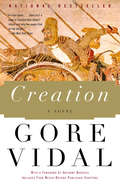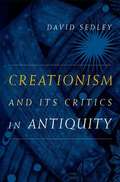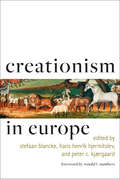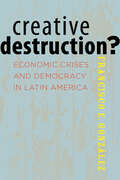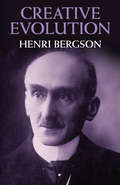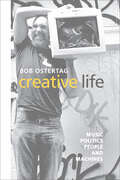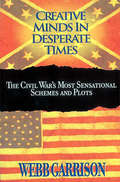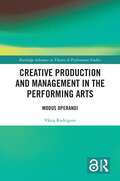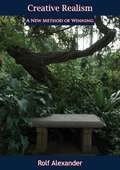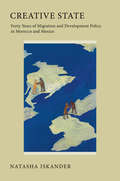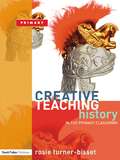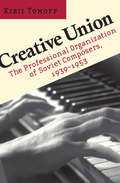- Table View
- List View
Creation: A Novel (Vintage International)
by Gore VidalOnce again the incomparable Gore Vidal interprets and animates history -- this time in a panoramic tour of the 5th century B.C. -- and embellishes it with his own ironic humor, brilliant insights, and piercing observations. We meet a vast array of historical figures in a staggering novel of love, war, philosophy, and adventure . . . "There isn't a page of CREATION that doesn't inform and very few pages that do not delight."-- John Leonard, The New York Times
Creationism and Its Critics in Antiquity
by David N. SedleyThe world is configured in ways that seem systematically hospitable to life forms, especially the human race. Is this the outcome of divine planning, or simply of the laws of physics? Ancient Greeks and Romans famously disagreed on whether the cosmos was the product of intelligent design or of accident. In Creationism and its Critics in Antiquity, David Sedley examines this question and illuminates new historical perspectives on the pantheon of thinkers who laid the foundations of western philosophy and science. Versions of what today we call the "creationist" option were widely favored by the major thinkers of classical antiquity, including Plato, whose ideas on the subject prepared the ground for Aristotle's celebrated teleology. But Aristotle himself excluded any role for divine intervention, in this respect aligning himself with the anti-creationist lobby, whose most militant members--the atomists--sought to show how a world just like ours would inevitably form by sheer accident, given only the infinity of space and matter. This stimulating study explores seven major thinkers or philosophical movements who were enmeshed in the debate: Anaxagoras, Empedocles, Socrates, Plato, the atomists, Aristotle, and the Stoics. An epilogue considers their debate from the viewpoint of Galen, the great second-century A. D. doctor, who was also a leading voice of creationism. Adapted from Sedley's 2004 Sather Lectures at the University of California, Berkeley, this the first book-length study of an old debate.
Creationism in Europe (Medicine, Science, And Religion In Historical Context Ser.)
by Stefaan Blancke, Hans Henrik Hjermitslev, and Peter C. KjærgaardA history of Creationism in Europe, from its reception to its rise and the response that has followed.For decades, the creationist movement was primarily situated in the United States. Then, in the 1970s, American creationists found their ideas welcomed abroad, first in Australia and New Zealand, then Korea, India, South Africa, Brazil, and elsewhere—including Europe, where creationism plays an expanding role in public debates about science policy and school curricula. In this, the first comprehensive history of creationism in Europe, leading historians, philosophers, and scientists narrate the rise of—and response to—scientific creationism, creation science, intelligent design, and organized antievolutionism in countries and religions throughout Europe.Providing a map of creationism in Europe, the authors chart the history of creationist activities and strategies. Over the past forty years, creationism has spread swiftly among European Catholics, Protestants, Jews, Hindus, and Muslims, even as anti-creationists sought to halt it. Anti-evolution messages gained such widespread approval, in fact, that in 2007 the Parliamentary Assembly of the Council of Europe passed a resolution advising member states to “defend and promote scientific knowledge” and “firmly oppose the teaching of creationism as a scientific discipline on an equal footing with the theory of evolution.”Creationism in Europe offers an introduction to the cultural history of modern Europe, the variety of worldviews in Europe, and the interplay of science and religion in a global context. It will be of interest to students and scholars in the history and philosophy of science, religious studies, and evolutionary theory, as well as policy makers and educators concerned about the spread of creationism in our time.
Creationism in Europe (Medicine, Science, and Religion in Historical Context)
by Stefaan Blancke, Hans Henrik Hjermitslev, and Peter C. KjærgaardAmerican creationists’ efforts to export their beliefs have succeeded in Europe beyond their own expectations, winning followers across creed and country.For decades, the creationist movement was primarily situated in the United States. Then, in the 1970s, American creationists found their ideas welcomed abroad, first in Australia and New Zealand, then in Korea, India, South Africa, Brazil, and elsewhere—including Europe, where creationism plays an expanding role in public debates about science policy and school curricula. In this, the first comprehensive history of creationism in Europe, leading historians, philosophers, and scientists narrate the rise of—and response to—scientific creationism, creation science, intelligent design, and organized antievolutionism in countries and religions throughout Europe.Providing a unique map of creationism in Europe, the authors chart the surprising history of creationist activities and strategies there. Over the past forty years, creationism has spread swiftly among European Catholics, Protestants, Jews, Hindus, and Muslims, even as anti-creationists sought to smother its flames. Antievolution messages gained such widespread approval, in fact, that in 2007 the Parliamentary Assembly of the Council of Europe passed a resolution advising member states to "defend and promote scientific knowledge" and "firmly oppose the teaching of creationism as a scientific discipline on an equal footing with the theory of evolution." Creationism in Europe offers a discerning introduction to the cultural history of modern Europe, the variety of worldviews in Europe, and the interplay of science and religion in a global context. It will be of interest to students and scholars in the history and philosophy of science, religious studies, and evolutionary theory, as well as policy makers and educators concerned about the spread of creationism in our time.
Creative Destruction: How Globalization Is Changing the World's Cultures
by Tyler CowenA Frenchman rents a Hollywood movie. A Thai schoolgirl mimics Madonna. Saddam Hussein chooses Frank Sinatra's "My Way" as the theme song for his fifty-fourth birthday. It is a commonplace that globalization is subverting local culture. But is it helping as much as it hurts? In this strikingly original treatment of a fiercely debated issue, Tyler Cowen makes a bold new case for a more sympathetic understanding of cross-cultural trade. Creative Destruction brings not stale suppositions but an economist's eye to bear on an age-old question: Are market exchange and aesthetic quality friends or foes? On the whole, argues Cowen in clear and vigorous prose, they are friends. Cultural "destruction" breeds not artistic demise but diversity. Through an array of colorful examples from the areas where globalization's critics have been most vocal, Cowen asks what happens when cultures collide through trade, whether technology destroys native arts, why (and whether) Hollywood movies rule the world, whether "globalized" culture is dumbing down societies everywhere, and if national cultures matter at all. Scrutinizing such manifestations of "indigenous" culture as the steel band ensembles of Trinidad, Indian hand weaving, and music from Zaire, Cowen finds that they are more vibrant than ever- thanks largely to cross-cultural trade. For all the pressures that market forces exert on individual cultures, diversity typically increases within society, even when cultures become more like each other. Trade enhances the range of individual choice, yielding forms of expression within cultures that flower as never before. While some see cultural decline as a half-empty glass, Cowen sees it as a glass half-full with the stirrings of cultural brilliance. Not all readers will agree, but all will want a say in the debate this exceptional book will stir.
Creative Destruction?: Economic Crises and Democracy in Latin America
by Francisco E. GonzlezThis illuminating historical study examines the political economies of three Latin American countries in their transition toward democratization.Through most of the twentieth century, financial shocks toppled democratic and authoritarian regimes across Latin America. But things began to change in the 1980s. In this wide-ranging comparative history of Argentina, Uruguay, and Chile, Francisco E. González explains why.Gonzalez examines how these three countries were affected by the Great Depression, Latin America’s 1980s debt crisis, and the late 1990s emerging markets’ meltdowns. He finds that democratic or not, each nation’s regime gained stability in the 1980s thanks to changes in institutions, material interests, economic policies, and other factors. Underlying these developments was a growing ease in the exchange of ideas that created a pro-democracy bias—even in Pinochet’s Chile.With a concluding chapter on the impact of the Great Recession in other Latin American states, Eastern Europe, and East Asia, Creative Destruction? lends insight into the survival of democratic and authoritarian regimes during times of extreme financial instability.
Creative Destruction?: Economic Crises and Democracy in Latin America
by Francisco E. GonzálezThroughout the twentieth century, financial shocks toppled democratic and authoritarian regimes across Latin America. But things began to change in the 1980s. This volume explains why this was the case in Argentina, Chile, and Uruguay.Taking a comparative historical approach, Francisco E. González looks at how the Great Depression, Latin America’s 1980s debt crisis, and the emerging markets' meltdowns of the late 1990s and early 2000s affected the governments of these three Southern Cone states. He finds that democratic or not, each nation’s governing regime gained stability in the 1980s from a combination of changes in the structure and functioning of national and international institutions, material interests, political ideologies, and economic paradigms and policies. Underlying these changes was a growing ease in the exchange of ideas. As the world’s balance of power transitioned from trilateral to bipolar to unipolar, international institutions such as the World Bank and the International Monetary Fund increased crisis interventions that backstopped economic freefalls and strengthened incumbents. Urban-based populations with relatively high per capita income grew and exercised their preference for the stability and prosperity they found as a class under democratic rule. These and other factors combined to substantially increase the cost of military takeovers, leading to fewer coups and an atmosphere friendlier toward domestic and foreign capital investment. González argues that this confluence created a pro-democracy bias—which was present even in Augusto Pinochet’s Chile—that not only aided the states’ ability to manage economic and political crises but also lessened the political, social, and monetary barriers to maintaining or even establishing democratic governance. With a concluding chapter on the impact of the Great Recession in other Latin American states, Eastern Europe, and East Asia, Creative Destruction? lends insight into the survival of democratic and authoritarian regimes during times of extreme financial instability. Scholars and students of Latin America, political economy, and democratization studies will find González's arguments engaging and the framework he built for this study especially useful in their own work.
Creative Evolution
by Henri BergsonThe most famous and influential work of distinguished French philosopher Henri Bergson (1859–1941), Creative Evolution features the fullest expression of the philosopher's ideas about the problem of existence, propounding a theory of evolution completely distinct from these of earlier thinkers and scientists.In discussing the meaning of life, Bergson considers the order of nature and the form of intelligence, including the geometrical tendency of the intellect, and examines mechanisms of thought and illusion. In addition, he presents a critique of the idea of immutability and the concept of nothingness, from Plato and Aristotle through the evolutionism of his contemporaries.Bergson's influence on Marcel Proust and other twentieth-century writers renders a grasp of his theories imperative to students of literature as well as philosophy. Historians of science and other readers will also appreciate the importance of this milestone in philosophical and evolutionary thought.
Creative Historical Thinking
by Michael DoumaCreative Historical Thinking offers innovative approaches to thinking and writing about history. Author Michael J. Douma makes the case that history should be recognized as a subject intimately related to individual experience and positions its practice as an inherently creative endeavor. Douma describes the nature of creativity in historical thought, illustrates his points with case studies and examples. He asserts history’s position as a collective and community-building exercise and argues for the importance of metaphor and other creative tools in communicating about history with people who may view the past in fundamentally different ways. A practical guide and an inspiring affirmation of the personal and communal value of history, Creative Historical Thinking has much to offer to both current and aspiring historians.
Creative Involvement: The Evolution of China's Global Role (China Perspectives)
by Yizhou WangThis book continues the "creative involvement" proposition put forward in Creative Involvement: A New Direction in China's Diplomacy with new cases and stories to enrich its content. It discusses China's global role, and explores its root cause of formation, development stages, and future direction. The main conclusion is that this role is preliminary and incomplete and needs continuous learning and improvement; China standing on the global high ground needs not only hard power but also wisdom and creativity. On research methods and writing approach, firstly, this book follows the philosophy of "practice first", namely, starting from historical experiences, focusing on practical issues, and exploring objectives and clues through case studies. Secondly, the three parts in the book have different sub-themes, but they are subject to the same thinking, that is, how does China advance toward a central role from the marginal edge of contemporary international system, how to develop doctrines or practices for China’s involvement in world affairs, and how to borrow the experiences of others to help China move forward on the global high ground. Combing innovative theoretical idea with practical investigation, this book will not only contribute to contemporary China Diplomatic studies but also appeal to scholars and students of International Relation studies. People who are interested in the rise of China and global governance will also benefit from this book.
Creative Life: Music, Politics, People, and Machines
by Bob OstertagIn this eloquent and passionate volume, Bob Ostertag explores the common ground and points of friction among music, creativity, politics, culture, and technology. In terrain ranging from the guerrilla underground in El Salvador's civil war to the drag queen underground in San Francisco and New York, these essays combine journalism and autobiography to explore fundamental questions of what art is and what role it can occupy in a violent and fragmented world, a world in which daily events compromise the universality toward which art strives. Drawing on his intimate engagement with political conflict in Latin America and the Balkans, Ostertag identifies an art of "insurgent politics" that struggles to expand the parameters of the physical and social world. He also discusses his innovative collaborations with major modern performers, filmmakers, and artists around the world. Part memoir, part journalism, and part aesthetic manifesto, Creative Life is a dazzling set of writings from a musical artist who has worked on the cutting edge of new music for thirty years.
Creative Minds in Desperate Times
by Webb GarrisonWhen the Civil War broke out, leaders on both sides had to develop strategies for fighting the conflict and considered almost any suggestion. This book chronicles some of the most intriguing and unusual plans devised by these leaders.
Creative Ozone: The Artists of Westbeth
by Miriam ChaikenA captivating portrait of Westbeth, the legendary artists’ residence that shaped contemporary art, activism, and New York’s cultural landscape for over fifty years In 1970, the former Bell Telephone Laboratories in Manhattan was transformed into Westbeth, an ambitious experiment in urban renewal that became the world’s largest and longest-running artists’ residence. Home to generations of visual artists, musicians, writers, dancers, and performers, Westbeth has fostered creativity, community, and activism for over fifty years. From legendary photographer Diane Arbus and conceptual artist Hans Haacke to avant-garde theater pioneers like Joe Chaikin and Gloria Miguel, Westbeth has nurtured some of the most influential voices in contemporary art. Beyond its creative legacy, the residence has been a hub for social change. Its artists played leading roles in the anti-Vietnam protests, LGBTQ+ rights movements, feminist art collectives, and urban preservation efforts. In Creative Ozone, Miriam Chaiken offers a rare insider’s look at this extraordinary community. Drawing on intimate interviews with multiple generations of Westbeth residents, including those who grew up in the building as “feral children” immersed in art from birth, Chaiken captures the spirit of a place where creativity and activism are inseparable. She explores how Westbeth artists have weathered gentrification, economic upheavals, and major historical events, from 9/11 and Hurricane Sandy to the ongoing pandemic, revealing the resilience of this one-square-block artistic village. Blending vivid storytelling with cultural history, Creative Ozone is a tribute to the artists who shaped, and were shaped by, New York City. Rich with character-driven narratives, this book will captivate art lovers, history buffs, and anyone fascinated by the creative life. Whether you’re drawn to the bohemian legends of Greenwich Village, the evolution of urban spaces, or the intersection of art and activism, Creative Ozone offers an unforgettable portrait of a community like no other.
Creative Pasts
by Prachi DeshpandeThe "Maratha period" of the seventeenth and eighteenth centuries, when an independent Maratha state successfully resisted the Mughals, is a defining era in the history of the region of Maharashtra in western India. In this book, Prachi Deshpande considers the importance of this period for a variety of political projects including anticolonial/Hindu nationalism and the non-Brahman movement, as well as popular debates throughout the nineteenth and twentieth centuries concerning the meaning of tradition, culture, and the experience of colonialism and modernity.Sampling from a rich body of literary and cultural sources, Deshpande highlights shifts in history writing in early modern and modern India and the deep connections between historical and literary narratives. She traces the reproduction of the Maratha period in various genres and public arenas, its incorporation into regional political symbolism, and its centrality to the making of a modern Marathi regional consciousness. She also shows how historical memory provided a space for Indians to negotiate among their national, religious, and regional identities, pointing to history's deeper potential in shaping politics within thoroughly diverse societies.A truly unique study, Creative Pasts examines the practices of historiography and popular memory within a particular colonial context, and illuminates the impact of colonialism on colonized societies and cultures. Furthermore, it shows how modern history and historical memory are jointly created through the interplay of cultural activities, power structures, and political rhetoric.
Creative Pasts: Historical Memory and Identity in Western India, 1700-1960 (Cultures of History)
by Prachi DeshpandeThe "Maratha period" of the seventeenth and eighteenth centuries, when an independent Maratha state successfully resisted the Mughals, is a defining era in the history of the region of Maharashtra in western India. In this book, Prachi Deshpande considers the importance of this period for a variety of political projects including anticolonial/Hindu nationalism and the non-Brahman movement, as well as popular debates throughout the nineteenth and twentieth centuries concerning the meaning of tradition, culture, and the experience of colonialism and modernity. Sampling from a rich body of literary and cultural sources, Deshpande highlights shifts in history writing in early modern and modern India and the deep connections between historical and literary narratives. She traces the reproduction of the Maratha period in various genres and public arenas, its incorporation into regional political symbolism, and its centrality to the making of a modern Marathi regional consciousness. She also shows how historical memory provided a space for Indians to negotiate among their national, religious, and regional identities, pointing to history's deeper potential in shaping politics within thoroughly diverse societies.A truly unique study, Creative Pasts examines the practices of historiography and popular memory within a particular colonial context, and illuminates the impact of colonialism on colonized societies and cultures. Furthermore, it shows how modern history and historical memory are jointly created through the interplay of cultural activities, power structures, and political rhetoric.
Creative Politics
by Glenn BeamerState legislators are constantly making tradeoffs between changing taxes and providing public services. Not only must they reconcile their own policy preferences with the preferences of their constituents, but they must consider the impact of actions taken by both the federal government and competing states. Glenn Beamer uses a series of in-depth case studies in eleven states to show how legislators made decisions dealing with taxation, economic development, education financing, and Medicaid. Beamer identifies six factors that influence legislators' decisions: accountability, dependability, equity, obscurability, and horizontal and vertical transferability. Within the context created by citizen demands, intergovernmental politics, policy histories, court interventions, and state constitutions, this study analyzes how legislators employ these principles to develop and enact policies. In addition to modeling state politics within the context of federalism, Creative Politics, reflecting the author's extensive interviews with legislators, is novel in its focus on politicians' views about public services, the strategies to finance them, and efforts to develop and maintain political support for them. This book will be of interest to students and scholars of political science, economics, and public administration, and, more specifically, of federalism, state politics and policy, and legislative decision-making.
Creative Power of Silence
by Swami ParamanandaSilence, the great unseen power, the miracle of life, works upon our character with strange contrast.Prior to spiritual studies, the idea of complete silence is strongly advocated by many. In practicing the silence, it is found to unfold our higher nature. The silence allows concentration. With the intrusion of noise, the mind cannot be receptive.Contrary to some belief, the silence is not to free the mind to allow emptiness. It means co-ordination of body and mind. It reduces friction and becomes a definite factor for our concentrated thought. The silence is essential for all forms of study. “A silent being is a very restful being. All wise people realize the deeper part of our nature can only be expressed effectively when our outer being is still.”
Creative Production and Management in the Performing Arts: Modus Operandi (Routledge Advances in Theatre & Performance Studies)
by Vânia RodriguesThis volume takes stock of the ways in which the regimes of artistic creation and production intersect, lending special attention to emergent discourses and work models of producing and managing theatre, dance, and performance – through the lenses of creative producers.This book suggests that social protection failures, longstanding institutional shortcomings, and the dilemmas of social and environmental sustainability are pushing arts management and production modi operandi towards a review of its expansionist assumptions and managerial hyper-productivist processes. By documenting singular ‘counter-management’ experiences in Portugal, Belgium, France, and Brazil, this study makes a strong claim for a reassessment of the role of producers and art managers as reflective practitioners and as pivotal elements towards more sustainable artistic practices.This study will be of great interest to students and scholars in theatre and performance studies, policymakers, and cultural professionals.Chapter 2 and Conclusion of this book is freely available as a downloadable Open Access PDF at http://www.taylorfrancis.com under a Creative Commons [Attribution-Non Commercial-No Derivatives (CC-BY-NC-ND)] 4.0 license.
Creative Realism: A New Method of Winning
by Rolf AlexanderOriginally published in 1954, Creative Realism: A New Method of Winning provides a simple process of self-hypnosis whereby you can free the mind from its fragmentation in the subconscious.Dr. Rolf Alexander theorizes that we are all hypnotized to a considerable degree by what has happened to or around us in our lives. Assigning many of our personality troubles on “hypnosis-without-a-hypnotist,” he offers a method which he calls ‘self-realization,’ and which is used to dehypnotize ourselves. The use of this method is urged as a preliminary to the administering of autosuggestion, and provides an antidote to remaining in a suggestible trance to some extent after the use of autohypnosis.Dr. Rolf Alexander devoted himself to a lifelong program of private research and experimentation, and following extensive worldwide travel and the meticulous investigation of many little-known systems, he discovered the new and revolutionary philosophy named ‘Creative Realism,’ which this book outlines.
Creative Simulations: George Mallen and the Early Computer Arts Society (Springer Series on Cultural Computing)
by Catherine MasonThis book is centred on the practitioner-led Computer Arts Society founded in 1969 and formed to address creative computation in all the arts – performance, poetry, text, sound, sculpture and graphics. The objectives and achievements of the Computer Arts Society are presented as realised through their members and exhibitions to the mid-1970s. The Society’s co-founder is Dr George Mallen, a pioneer of cybernetic systems and cultural applications of computing. Creative Simulations contains new research including Mallen’s early work with cybernetician Gordon Pask, whose concepts of interdisciplinarity were influential on the ground-breaking Ecogame (1970). Led by Mallen, Ecogame was a collaborative Computer Arts Society project, an early embodiment of computer technology into art and the first multi-media interactive gaming system in the UK. Pask’s influence in Mallen’s subsequent role at the Royal College of Art where he instigated the first computerlab facilities for artists, is examined. A recently discovered lecture given by Mallen is transcribed, along with reproduction of historic texts by Stephen Willats and John Lansdown (two of his colleagues), which add context to this history of interdisciplinary artistic innovation in the digital realm. Illustrations include art works, ephemera, exhibition posters and installations, preparatory drawings, computing equipment and associated flow charts and diagrams, many appearing here in print for the first time.
Creative State: Forty Years of Migration and Development Policy in Morocco and Mexico
by Natasha IskanderAt the turn of the twenty-first century, with the amount of money emigrants sent home soaring to new highs, governments around the world began searching for ways to capitalize on emigration for economic growth, and they looked to nations that already had policies in place. Morocco and Mexico featured prominently as sources of "best practices" in this area, with tailor-made financial instruments that brought migrants into the banking system, captured remittances for national development projects, fostered partnerships with emigrants for infrastructure design and provision, hosted transnational forums for development planning, and emboldened cross-border political lobbies. In Creative State, Natasha Iskander chronicles how these innovative policies emerged and evolved over forty years. She reveals that the Moroccan and Mexican policies emulated as models of excellence were not initially devised to link emigration to development, but rather were deployed to strengthen both governments' domestic hold on power. The process of policy design, however, was so iterative and improvisational that neither the governments nor their migrant constituencies ever predicted, much less intended, the ways the new initiatives would gradually but fundamentally redefine nationhood, development, and citizenship. Morocco's and Mexico's experiences with migration and development policy demonstrate that far from being a prosaic institution resistant to change, the state can be a remarkable site of creativity, an essential but often overlooked component of good governance.
Creative Teaching: History in the Primary Classroom
by Rosie Turner-BissetDesigned specifically for teachers with little subject knowledge or experience in history, this book provides trainees with the confidence they need to teach primary history. Based on Curriculum 2000, the book provides valuable step-by-step guidance on how to create, plan, develop, organize and assess high-quality teaching activities in primary history. This book: is full of teaching approaches, practical ideas, teaching activities, real-life case studies and vignettes of good teaching practice; covers both conventional and modern approaches - such as drama, role-play, story telling, music and dance; and explains how each approach can be adapted to suit all primary ages and abilities. Children with a range of learning needs and styles respond with enthusiasm to a wide variety of teaching approaches - and this book provides trainee teachers with that repertoire and variety.
Creative Union: The Professional Organization of Soviet Composers, 1939–1953
by Kiril TomoffWhy did the Stalin era, a period characterized by bureaucratic control and the reign of Socialist Realism in the arts, witness such an extraordinary upsurge of musical creativity and the prominence of musicians in the cultural elite? This is one of the questions that Kiril Tomoff seeks to answer in Creative Union, the first book about any of the professional unions that dominated Soviet cultural life at the time. Drawing on hitherto untapped archives, he shows how the Union of Soviet Composers established control over the music profession and negotiated the relationship between composers and the Communist Party leadership. Central to Tomoff's argument is the institutional authority and prestige that the musical profession accrued and deployed within Soviet society, enabling musicians to withstand the postwar disciplinary campaigns that were so crippling in other artistic and literary spheres.Most accounts of Soviet musical life focus on famous individuals or the campaign against Shostakovich's Lady Macbeth and Zhdanov's postwar attack on musical formalism. Tomoff's approach, while not downplaying these notorious events, shows that the Union was able to develop and direct a musical profession that enjoyed enormous social prestige. The Union's leadership was able to use its expertise to determine the criteria of musical value with a degree of independence. Tomoff's book reveals the complex and mutable interaction of creative intelligentsia and political elite in a period hitherto characterized as one of totalitarian control.
Creative Ways to apply Historical GIS: Promoting Research and Teaching about Europe
by Jordi Martí-HennebergThis volume promotes the use of Historical GIS (H-GIS) for both education and research. It consists of a coherent set of chapters that allow readers to study the spatial histories of cities, infrastructure, landscapes, and more across Europe. Each chapter is accompanied by Electronic Supplementary Material (ESM) including GIS data, guides and complementary material in .pdf format, and more. To date, there are no similar materials available in this field compiled in a single book. Interdisciplinarity in spatial research is a main theme of this volume, and the text and tools provided here allow readers to combine inputs relating to the study of earth sciences, population, urban growth and transportation, focusing on changes over both space and time. Each chapter provides data in GIS format and also a user's guide to enable readers to deeply engage with the contents themselves. Guidelines are provided to help locate new data about other areas of the world, which users will be able to develop independently. The book is divided into three parts, each presenting different scales of study and analysis at the local, regional and national levels. Part One deals with general subjects analyzed across large areas, mainly within Europe. Part Two provides more specific subjects and data. Part Three covers sources and teaching with H-GIS. The book will be of interest to researchers, academics, teachers and students from secondary schools up to university level. Each subject and tutorial is aimed at a multi-level audience.
Creative Women of the “Lost Generation”: Women in the Arts in the Wake of the Great War (Routledge Studies in First World War History)
by Kimberly Francis Margot IrvineThis book explores the creative women of the "Lost Generation" including painters, sculptors, film makers, writers, singers, composers, dancers, and impresarios who all pursued artistic careers in the years leading up to, during, and following World War I. These women’s stories, and the art they created, commissioned, mobilized as propaganda, and performed shed light on the shifting nature of gender norms during this period. With the combined knowledge and expertise from different contributors, chapters in this book consider how modernist practices continued their development in women’s hands during the war through networks forged by and for women artists in the absence of their male colleagues. These chapters also reflect on how, in many cases, the dissolution of these structures after the November 1918 armistice had detrimental consequences for their professional trajectories. This book challenges the place creative women currently hold in the historical record while also clarifying how these artists and impresarios contributed to wartime and post-war culture. This collection of essays will be of great value to scholars interested in social and gender history of the twentieth century, as well as historians of the arts through offering nuanced understanding of the essential work of female creative professionals, highlighting artistic women’s experiences of resistance, mourning, and reinvention in the shadow of the Great War.
